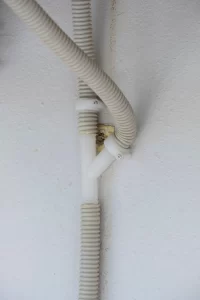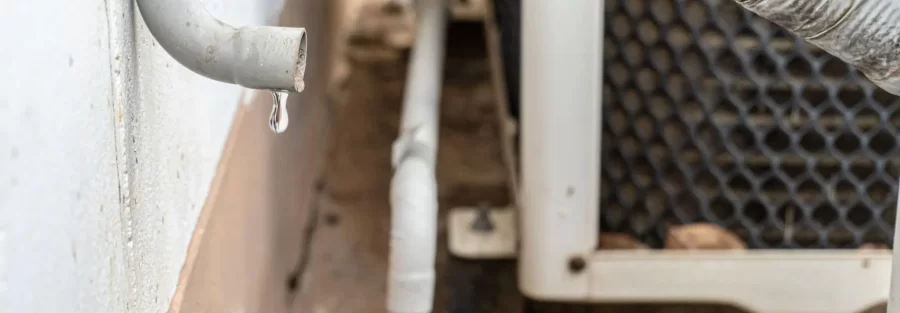Air Conditioning Drain Line System
The AC condensate drain line is one of the most underrated but crucial parts of the HVAC system. Your air conditioner cools your house, but it also controls humidity, which needs a properly functioning drain line.
The technology removes moisture from the indoor air to make your area pleasant. The extra moisture drips into the condensate drain pan, where it passes via the AC drain line and leaves the system.
What is AC Drain Line?

The condensation can travel from the unit to a drain or outside through the AC drain line, a tiny pipe that carries water and debris from the condensate drain pan underneath the evaporator coil. That moisture has to be drained for the system to work correctly. There is a chance that dirt and other debris will flow with the water as it drops from the evaporator coils into the condensate pan and drain line.
A blockage can develop in the drain line if too much dirt builds up there. Given that the line is in charge of discharging extra moisture, mold and mildew can easily grow there and contribute to the clogged line.
Dirt, mold, and mildew can clog the condensate drain line if they are not removed. We’re here to assist you in understanding how to maintain the line clear and what to do if you suspect a blockage since a clogged AC drain line might cause a full system failure.
Sign Of AC Drain Line Clogged
Some more recent HVAC systems feature sensors that will warn you if your AC drain line is plugged so you may take action before any water damage occurs. If your unit lacks this technology, you’ll be able to tell the AC drain line is clogged if you see that your drain pan is overflowing with water. Make it a routine to inspect your drain pan after each filter replacement so that any problems may be identified quickly. Secondly, your air conditioning system not functioning is one of the most evident indicators of a blocked AC pipe. The drain pipe in your air conditioner ensures that any surplus moisture is removed. When everything is functioning properly, you should be able to see a small trickle of water at the end of a PVC pipe outside your house; here is where the moisture flows. Here are the problems that might result in a blockage or a backlog of water. The area around the air handler unit is flooded, which is another indicator of an AC drain pipe obstruction.
The water safety switch would have been activated, prohibiting your AC from cooling or working at all as a result of a clogged AC pipe.
Your safety switch may have lost operation because to water in the area.
A musty odor permeated the entire house. This can be the result of an accumulation inside the system. Your air conditioner is still on, but it smells bad. If mold is found, take immediate action because it has been linked to health problems.
You could be dealing with a potential blockage if your condensate pan is frequently full. Act on this as soon as you can to stop the growth of mold.
Can I Clean the AC Drain line By Myself?
You can possibly unclog the AC drain line yourself if the damage it has caused isn’t too severe. The blockage may be creating more significant problems, though, if your HVAC stops operating or you smell mold or mildew coming from the unit or vents. A professional is required for complex problems.
How To Unclog AC Drain Line
If you find the blockage early enough, you may use only a few tools to unclog an AC drain line in a matter of minutes. Many experts advise against using strong chemicals like Drano to clear the block. To clear a clogged AC drain line, take the following actions:
- Gather the necessary tools You might need a bucket or pan to capture the running water, a wire brush or pipe cleaner to gently unblock the line and a cleaning agent like vinegar or bleach mixed with water.
- Disconnect the AC’s power: Working with water and electricity together might be risky. Before you begin, turn off the unit’s electricity at the breaker.
- Take off the drain line’s cap: You may have noticed that the drain pipe is T-shaped and has a cap at the top. To get a closer look at the clog, remove the cap.
- Search for the obstruction: After removing the cap, look for any evident obstructions caused by hair or dirt. Pull the clog out carefully if you can do so without pushing it farther down the pipe.
- Remove obstructions in the line: To remove obstructions in the line, use a pipe cleaner or wire brush.
- Pour in diluted vinegar or bleach solution: Pour the prepared solution into the pipe, depending on the severity of the blockage, and let it sit for 30 minutes or more to further dissolve any obstructions.
- Flush the pipe: Rinse the pipe with fresh water after draining the solution.
- Monitor the system’s Performance: You might need to get assistance from an expert if the AC drain line is still plugged.
How Often Should I Inspect The Drain Line?
Regularly inspecting the AC drain line helps prevent greater problems from occurring. The pan can overflow, flooding the area and causing moisture damage, if the line backs up and the water has nowhere to go.
Every time you replace the AC filters, make it a practice to inspect the condensate line. If AC drain lines are periodically checked, they are much simpler to clear. One of the initial indicators of an AC drain blockage is too much water in the drain pan.
Setting up seasonal checkups for your air conditioner is one of the greatest strategies to avoid a clogged AC drain line. Our team fixes any problem regarding heating & cooling which is making you uncomfortable. DGB Refrigeration is locally owned and well recognize around Melbourne.
Give us a call on 03 9005 5717 and get your service’s cost before we arrive for the job.



